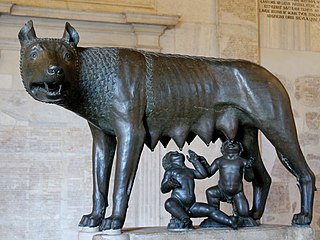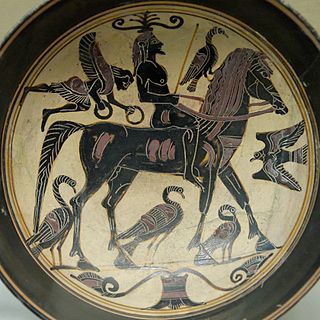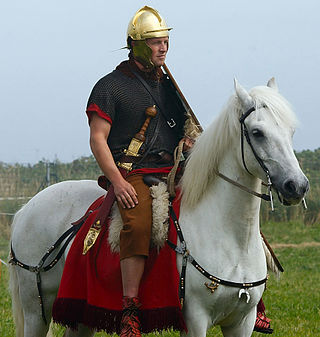Related Research Articles

The censor was a magistrate in ancient Rome who was responsible for maintaining the census, supervising public morality, and overseeing certain aspects of the government's finances.

The patricians were originally a group of ruling class families in ancient Rome. The distinction was highly significant in the Roman Kingdom, and the early Republic, but its relevance waned after the Conflict of the Orders. By the time of the late Republic and Empire, membership in the patriciate was of only nominal significance.
The equites constituted the second of the property-based classes of ancient Rome, ranking below the senatorial class. A member of the equestrian order was known as an eques.

In modern historiography, Ancient Rome refers to Roman civilisation from the founding of the Italian city of Rome in the 8th century BC to the collapse of the Western Roman Empire in the 5th century AD. It encompasses the Roman Kingdom, Roman Republic and Roman Empire until the fall of the western empire.

Aerarium, from aes + -ārium, was the name given in Ancient Rome to the public treasury, and in a secondary sense to the public finances.

The cursus publicus was the state mandated and supervised courier and transportation service of the Roman Empire, later inherited by the Eastern Roman Empire. It was a system based on obligations placed on private persons by the Roman State. As contractors, called mancipes, they provided the equipment, animals, and wagons. In the Early Empire compensation had to be paid but this had fallen into abeyance in Late Antiquity when maintenance was charged to the inhabitants along the routes. The service contained only those personnel necessary for administration and operation. These included veterinarians, wagon-wrights, and grooms. The couriers and wagon drivers did not belong to the service: whether public servants or private individuals, they used facilities requisitioned from local individuals and communities. The costs in Late Antiquity were charged to the provincials as part of the provincial tax obligations in the form of a liturgy/munus on private individual taxpayers.

Social class in ancient Rome was hierarchical, with multiple and overlapping social hierarchies. An individual's relative position in one might be higher or lower than in another, which complicated the social composition of Rome.

Hippeis is a Greek term for cavalry. In ancient Athenian society, after the political reforms of Solon, the hippeus was the second highest of the four social classes. It was composed of men who had at least 300 medimnoi or their equivalent as yearly income. According to the Timocratic Constitution the average citizen had a yearly income of less than 200 medimnoi. This gave the men who made 300 medimnoi the ability to purchase and maintain a war horse during their service to the state.
The structural history of the Roman military concerns the major transformations in the organization and constitution of ancient Rome's armed forces, "the most effective and long-lived military institution known to history." At the highest level of structure, the forces were split into the Roman army and the Roman navy, although these two branches were less distinct than in many modern national defense forces. Within the top levels of both army and navy, structural changes occurred as a result of both positive military reform and organic structural evolution. These changes can be divided into four distinct phases.

In modern scholarship, the "late" period of the Roman army begins with the accession of the Emperor Diocletian in AD 284, and ends in 480 with the death of Julius Nepos, being roughly coterminous with the Dominate. During the period 395–476, the army of the Roman Empire's western half progressively disintegrated, while its counterpart in the East, known as the East Roman army remained largely intact in size and structure until the reign of Justinian I.

Fluting in architecture consists of shallow grooves running along a surface.

The Castra Nova equitum singularium was an ancient Roman fort in Rome housing part of the emperor's cavalry bodyguard. The site of the fort now lies beneath the Basilica of St John Lateran. The Castra Nova, or "new fort", was one of two cavalry forts that provided a base in Rome for the mounted bodyguard of the Roman emperors.

Roman cavalry refers to the horse-mounted forces of the Roman army throughout the Regal, Republican, and Imperial eras.

Mauri was the Latin designation for the Berber population of Mauretania, located in the part of North Africa west of Numidia, in present-day northern Morocco and northwestern Algeria.

The equites singulares Augusti were the cavalry arm of the Praetorian Guard during the Principate period of imperial Rome. Based in Rome, they escorted the Roman emperor whenever he left the city on a campaign or on tours of the provinces. The equites singulares Augusti were a highly trained unit dedicated to protecting the emperor. Men who served in the equites singulares Augusti held a Roman public status as equites.

The Servian constitution was one of the earliest forms of military and political organization used during The Roman Republic. Most of the reforms extended voting rights to certain groups, in particular to Rome's citizen-commoners who were minor landholders or otherwise landless citizens hitherto disqualified from voting by ancestry, status or ethnicity, as distinguished from the hereditary patricians. The reforms thus redefined the fiscal and military obligations of all Roman citizens. The constitution introduced two elements into the Roman system of government: a census of every male citizen, in order to establish his wealth, tax liabilities, military obligation, and the weight of his vote; and the comitia centuriata, an assembly with electoral, legislative and judicial powers. Both institutions were foundational for Roman republicanism.
The aes hordearium was an annual allotment of 2000 asses paid during the Roman Republic to an equus publicus for his military horse's upkeep. This money was paid by single women, which included both maidens and widows (viduae), and orphans (orbi), provided they possessed a certain amount of property, on the principle, as Barthold Georg Niebuhr remarks, "that in a military state, the women and children ought to contribute for those who fight in behalf of them and the commonwealth; it being borne in mind, that they were not included in the census." The equites had a right to distrain if the aes hordearium was not paid.
The aes equestre was an allotment paid during the Roman Republic to each cavalryman to provide him with a horse. This was said to have been instituted by Servius Tullius as part of his reorganization of the military. This allotment was 10,000 asses, to be given to the Equus publicus out of the public treasury of Rome. A similar allotment, the aes hordearium paid for the horses' upkeep, and was funded by a tax of 2,000 ases annually on unmarried women and orphans possessing a certain amount of property

This article presents a chronology of sporting development and events from time immemorial until the end of the 10th century CE. The major sporting event of the ancient Greek and Roman periods was the original Olympic Games, which were held every four years at Olympia for over a thousand years. Gladiatorial contests and chariot racing were massively popular. Some modern sports such as archery, athletics, boxing, football, horse racing and wrestling can directly trace their origins back to this period while later sports like cricket and golf trace their evolution from basic activities such as hitting a stone with a stick.